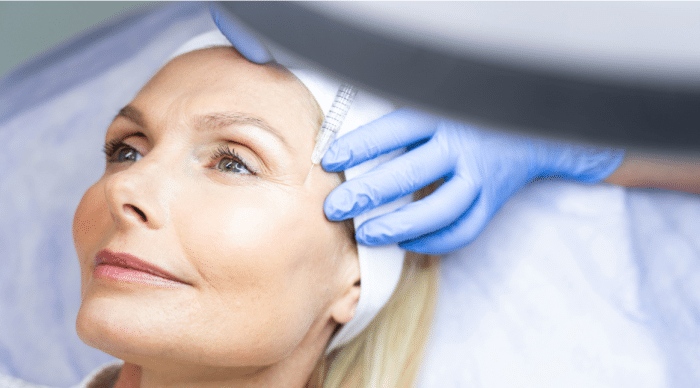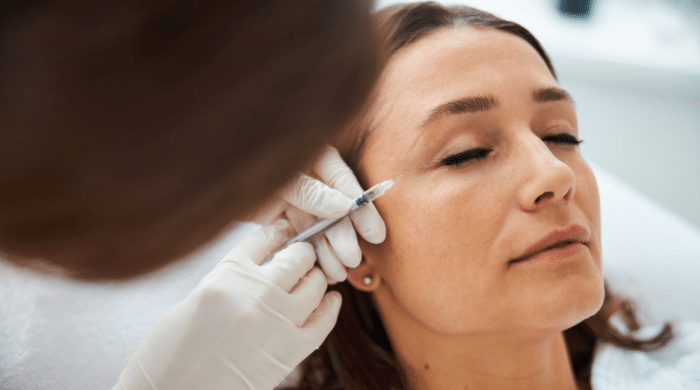
The Importance Of Patient Education: Understanding And Addressing Dysport Crow’s Feet Side Effects
David Fuller
Last Updated On: April 9, 2024

According to the Food and Drug Administration, Dysport temporarily improves the appearance of crow’s feet, with over 95% reporting positive outcomes within two days post-treatment. This statistic highlights Dysport’s effectiveness in cosmetic procedures and underscores the importance of understanding its potential side effects.
While Dysport presents a promising solution for those looking to rejuvenate their appearance, it is not without its side effects. Addressing and understanding these potential reactions are crucial for patients considering this treatment option. This article will delve into the importance of patient education in cosmetic treatments, focusing on Dysport’s application for crow’s feet.
Key Takeaways
- Understanding potential side effects and management is crucial for patients considering Dysport for crow’s feet.
- Dysport effectively reduces the appearance of crows’ feet, with temporary side effects like injection site reactions and sometimes eyelid drooping.
- Healthcare providers must educate patients on the benefits, risks, and importance of follow-up care to adjust treatment plans based on feedback.
- Avoiding certain activities and substances before treatment and using ice packs can help minimize side effects.
- Scheduled follow-up appointments allow healthcare providers to assess treatment effectiveness and adjust plans, enhancing patient satisfaction.
Understanding Crow’s Feet and Dysport Treatment

Discover what crow’s feet are, why they appear, and how Dysport can be a game-changer in treating these signs of aging around the eyes.
What Causes Crow’s Feet?
Crow’s feet, or lateral canthal lines, are wrinkles at the eyes’ outer corners. They’re a natural part of aging, often influenced by facial expressions such as smiling, frowning, or squinting, which cause tiny muscles around the eyes to contract. These lines can start as dynamic wrinkles, visible only with facial expressions. They can become static, remaining visible even when the face rests.
Aging, sun exposure, lifestyle choices, and the natural decrease of collagen and elastin in the skin contribute to the development of crow’s feet. The thin skin around the eyes is particularly susceptible to these factors, with sun damage and squinting being significant contributors.
Aging can lead to reduced collagen and elastin, essential for maintaining the skin’s youthful appearance. Lifestyle habits like sun exposure without protection, not using sunglasses, and a poor diet can exacerbate their formation. Interestingly, men may experience crow’s feet earlier and more intensely than women, potentially due to differences in skin composition and sun protection habits.
How Does Dysport Work to Treat Crow’s Feet?
Dysport is a botulinum toxin that temporarily paralyzes the muscles responsible for creating wrinkles, including those around the eyes. When injected into the specific muscles causing crow’s feet, Dysport blocks the nerve signals that cause these muscles to contract. As a result, the skin over the muscle smooths out, reducing the appearance of the crow’s feet.
While Botox is another popular treatment, Dysport is specifically designed for use in various areas, including the delicate skin around the eyes. It’s essential to consult with a dermatologist or a qualified healthcare provider to determine the best treatment plan for crow’s feet and other wrinkles.
Common Side Effects of Dysport for Crow’s Feet
Learn about the typical side effects patients might experience with Dysport treatments for crow’s feet and understand the reasons behind these reactions.
Listing Common Side Effects Experienced by Patients
Common side effects of Dysport include injection site reactions such as pain, redness, swelling, headache, neck stiffness, and, in some cases, eyelid drooping (ptosis). These side effects are usually temporary and resolve on their own. The risk of experiencing these side effects can vary depending on the individual’s skin sensitivity and the specific treatment area.
Explaining Why These Side Effects Occur
The side effects associated with Dysport, such as skin irritation or more specific reactions like eyelid drooping, occur due to the injection’s action on the muscles and the skin’s response to the treatment. The temporary paralysis of the muscles can sometimes affect adjacent areas, leading to drooping if the toxin spreads beyond the intended treatment zone.
Skin irritation and other local reactions can result from the body’s response to the injection or the botulinum toxin. These reactions are generally mild and temporary, but seeking medical advice is crucial if side effects persist or any severe reactions occur.
Importance of Patient Education Before Treatment

Explore the critical role of informed consent and understanding before undergoing Dysport treatments.
Role of Healthcare Providers in Educating Patients
Healthcare providers must educate patients about Dysport treatments, including the benefits, risks, and realistic outcomes. Effective patient education should cover the specifics of Dysport, including how it works to smooth out wrinkles caused by muscle contractions and the typical experience during and after treatment.
Discussing Potential Side Effects and Managing Expectations
Before undergoing Dysport injections, patients should be made aware of possible side effects, including problems swallowing, breathing, or speaking due to the spread of toxin effects. Discussing these risks upfront helps manage patients’ expectations and prepare them for the treatment process.
This conversation should also cover critical safety information regarding contraindications and the importance of disclosing all medical conditions and medications.
Managing and Mitigating Side Effects
Delve into strategies for minimizing the discomfort and risks associated with Dysport injections, from practical tips for patients to essential advice on when to seek medical attention for any adverse effects.
Tips for Patients to Minimize Side Effects
Patients can take several steps, such as avoiding alcohol and blood-thinning medications before treatment, using ice packs to reduce swelling, and keeping the injection site clean. This is to minimize potential side effects from Dysport injections.
It’s also recommended that the treatment be done at least two to three weeks before any major events to allow the effects to manifest fully and for any side effects to subside.
When to Seek Medical Advice for Side Effects
While most side effects are mild and temporary, such as injection site swelling, redness, or tenderness, patients should be informed about the signs that require immediate medical attention. These include severe headaches, signs of infection, numbness, or rapid changes in sensation or muscle strength.
Prompt communication with a healthcare provider is essential for addressing any severe or persistent side effects following Dysport injections.
The Role of Follow-Up Care in Patient Satisfaction
Discover how scheduled follow-up appointments are critical in enhancing patient satisfaction and treatment outcomes with Dysport. They ensure that each patient’s journey towards smoother skin is carefully monitored and adjusted as needed.
Importance of Scheduling Follow-Up Appointments
During the initial consultation, your provider will assess your current skin condition and medical, social, and family history to tailor a personalized treatment plan. Follow-up appointments allow the provider to evaluate the effectiveness of the treatment, adjust the plan based on the observed outcomes, and address any concerns or side effects experienced by the patient.
Preparing for your Dysport session involves avoiding certain substances and activities that could affect the results or increase the likelihood of side effects. It’s recommended to book your treatment at least two to three weeks before any major events to allow the effects to manifest fully.
Adjusting Treatment Plans Based on Patient Feedback and Side Effects
Adjusting the treatment plan based on patient feedback and the occurrence of any side effects is an integral part of follow-up care. The initial outcomes and any side effects, such as swelling, redness, or discomfort, are typically discussed during these appointments.
Providers can then adjust the treatment strategy, ensuring that future sessions align more with the patient’s expectations and comfort levels. Understanding and addressing patient concerns during follow-up visits contribute to overall satisfaction and treatment success.
The Bigger Picture: Patient Education and Treatment Success
Uncover how informed decision-making and comprehensive patient education form the cornerstone of successful Dysport treatments. These lead to higher levels of satisfaction and more effective results for patients seeking to minimize the appearance of crow’s feet.
How Informed Patients Make Better Decisions About Their Care
Patients are likelier to make decisions that enhance their treatment success. Knowledge about Dysport’s potential side effects and aftercare allows patients to set realistic expectations and follow through with recommended practices that optimize results. Patient education also includes discussing the differences between dynamic and static wrinkles and the areas where Dysport is most effective, guiding patients to make informed choices about their care.
The Impact of Patient Education on Overall Satisfaction and Results
Educated patients understand the necessity of follow-up appointments, are more likely to adhere to aftercare instructions, and can identify when to seek medical advice for side effects. This fosters a collaborative patient-provider relationship, ensuring that treatment goals are met and potentially reducing the likelihood of dissatisfaction or complications. Ultimately, patient education is critical to the treatment process, contributing to better outcomes and higher patient satisfaction.
Conclusion
Effective patient education and communication between healthcare providers and patients are foundational to the success of Dysport treatments for crow’s feet. Patients can significantly improve their treatment outcomes and satisfaction levels by understanding the procedure, managing expectations, and following aftercare recommendations.
Healthcare providers play a critical role in this process, ensuring that patients are well-informed about the benefits and risks of the treatment, how to minimize potential side effects and the importance of follow-up care. Together, informed decision-making and comprehensive patient education lead to more effective results and higher levels of patient satisfaction.
About: Established in 2016, Med Supply Solutions has emerged as a leading supplier of under eye and lip fillers, catering to medical practices seeking reliable products such as Dysport facial injections. With competitive pricing, they not only enhance practice profitability but also optimize resource utilization. Additionally, their commitment to customer satisfaction is evident through dedicated VIP sales agents, ensuring a seamless shopping experience while providing access to quality Dysport injections for facial rejuvenation at an exceptional value.
FAQs
- What are the common side effects of Dysport when treating crow’s feet?
Common side effects include injection site reactions, such as pain, redness, swelling, headache, neck stiffness, and occasionally eyelid drooping, which are generally temporary.
- How quickly can I expect results from Dysport treatments for crow’s feet?
Most patients report seeing positive outcomes within two days post-treatment.
- What should I do to minimize side effects after receiving Dysport?
Avoid alcohol and blood-thinning medications before treatment, use ice packs to reduce swelling, and keep the injection site clean.
- When should I seek medical advice after a Dysport injection?
Seek medical attention if you experience severe headaches, signs of infection, numbness, or rapid changes in sensation or muscle strength.
- Why is patient education important before undergoing Dysport treatment?
Educated patients are better prepared for what to expect, how to manage side effects, and the importance of follow-up care, leading to improved satisfaction and treatment outcomes.
References
U.S. Food and Drug Administration. (2016). Label for Dysport (abobotulinumtoxinA). Retrieved from https://www.accessdata.fda.gov/drugsatfda_docs/label/2016/125274s107lbl.pdf
Cleveland Clinic. (n.d.). Crow’s Feet. Retrieved from https://my.clevelandclinic.org/health/diseases/24586-crows-feet
Dysport. (n.d.). Official Patient Website. Retrieved from https://www.dysport.com/en-us
Dysport USA. (n.d.). Discover Dysport. Retrieved from https://www.dysportusa.com/discover-dysport
Products
Cart
Log In
Newsletter
Subscribe for exclusive offers and updates on new arrivals
Share feedback at:
Working Hours
MON - SUN 9AM to 6PM EST
The Most Popular Brands
Med Supply Solutions
Support
Secure checkout is guaranteed with full adherence to PCI DSS payment standards.
Products listed here are guaranteed authentic and manufacturer-sourced.
Pay easily with trusted providers


Copyright 2025. Med Supply Solutions